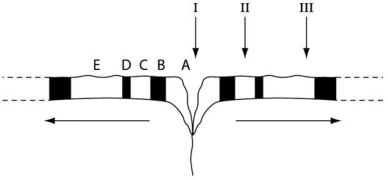Multiple Choice
Please use the following information to answer the questions below.
Figure 23.1 represents a cross section of the seafloor through a mid-ocean rift valley,with alternating patches of black and white indicating seafloor with reversed magnetic polarities.At the arrow labeled I (the rift valley) ,the igneous rock of the seafloor is so young that it can be accurately dated using carbon-14 dating.At the arrow labeled III,however,the igneous rock is about 1 million years old,and potassium-40 dating is typically used to date such rocks.Note: The horizontal arrows indicate the direction of seafloor spreading,away from the rift valley.
 Figure 23.1
Figure 23.1
-If a particular marine organism is fossilized in the sediments immediately overlying the igneous rock at the arrow labeled II,at which other location(s) ,labeled A-E,would a search be most likely to find more fossils of this organism?
A) B only
B) C only
C) D only
D) B and C
Correct Answer:

Verified
Correct Answer:
Verified
Q13: Radiometric dating is based on the<br>A)decay of
Q14: An organism has a relatively large number
Q15: The evolution of mammals from early tetrapods<br>A)is
Q16: Scientists,looking at the range of beak shapes
Q17: <img src="https://d2lvgg3v3hfg70.cloudfront.net/TB7910/.jpg" alt=" Figure 23.2 A
Q19: What is the benefit of using carbon
Q20: During the Cambrian explosion,fossil evidence indicates a
Q21: The appearance of Pax-6 in all animals
Q22: Which of the following statements about the
Q23: <img src="https://d2lvgg3v3hfg70.cloudfront.net/TB7910/.jpg" alt=" This evolutionary tree